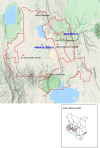Burden and risk factors of cutaneous leishmaniasis in a peri-urban settlement in Kenya, 2016
- PMID: 31971945
- PMCID: PMC6977748
- DOI: 10.1371/journal.pone.0227697
Burden and risk factors of cutaneous leishmaniasis in a peri-urban settlement in Kenya, 2016
Abstract
Background: Cutaneous leishmaniasis is a neglected disease known to cause significant morbidity among the poor. We investigated a suspected outbreak to determine the magnitude of cases, characterize the cases and identify risk factors of cutaneous leishmaniasis in Gilgil, a peri-urban settlement in Central Kenya.
Methods: Hospital records for the period 2010-2016 were reviewed and additional cases were identified through active case search. Clinical diagnosis of cutaneous leishmaniasis was made based on presence of ulcerative, nodular or papular skin lesion. The study enrolled 58 cases matched by age and neighbourhood to 116 controls in a case control study. Data was collected using structured questionnaires and simple proportions, means and medians were computed, and logistic regression models were constructed for analysis of individual, indoor and outdoor risk factors.
Results: Of the 255 suspected cases of cutaneous leishmaniasis identified, females constituted 56% (142/255) and the median age was 7 years (IQR 7-21). Cases occurred in clusters and up to 43% of cases originated from Gitare (73/255) and Kambi-Turkana (36/255) villages. A continuous transmission pattern was depicted throughout the period under review. Individual risk factors included staying outside the residence in the evening after sunset (OR 4.1, CI 1.2-16.2) and visiting forests (OR 4.56, CI 2.04-10.22). Sharing residence with a case (OR 14.4, CI 3.8-79.3), residing in a thatched house (OR 7.9, CI 1.9-45.7) and cracked walls (OR 2.3, CI 1.0-4.9) were identified among indoor factors while sighting rock hyraxes near residence (OR 5.3, CI 2.2-12.7), residing near a forest (OR 7.8, CI 2.8-26.4) and having a close neighbour with cutaneous leishmaniasis (OR 6.8, CI 2.8-16.0) were identified among outdoor factors.
Conclusions: We identify a large burden of cutaneous leishmaniasis in Gilgil with evidence of individual, indoor and outdoor factors of disease spread. The role of environmental factors and rodents in disease transmission should be investigated further.
Conflict of interest statement
The authors have declared that no competing interests exist.
Figures



References
-
- WHO| Leishmaniasis. WHO | Burden and distribution [Internet]. WHO. 2013 [cited 2016 Jan 14]. Available from: http://www.who.int/leishmaniasis/burden/en/
-
- Oryan A. Risk Factors Associated with Leishmaniasis. Trop Med Surg [Internet]. 2014. [cited 2016 Jan 16];02(03). Available from: http://www.esciencecentral.org/journals/risk-factors-associated-with-lei... = 25396
Publication types
MeSH terms
LinkOut - more resources
Full Text Sources

